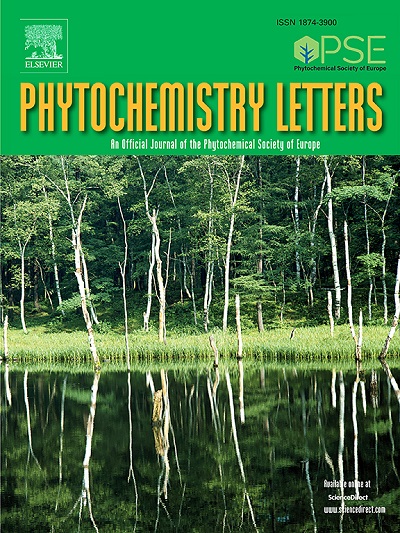Structurally diverse alkaloids from stems and leaves of Baphicacanthus cusia and their neuraminidase inhibitory activity
IF 1.4
4区 生物学
Q4 CHEMISTRY, MEDICINAL
引用次数: 0
Abstract
Three new alkaloids, namely, ethyl 2-[(1H-indol-3-ylcarbonyl)amino]benzoate (1), 3-[(R)-1-benzyl-1-ethoxycarbonyl]-2,4(1H,3H)-quinazolinedione (2), and (±)-11-ethoxycarbonyl-baphicacanthcusine D (3), along with 21 known alkaloids (4–25), were isolated from the stems and leaves of Baphicacanthus cusia. Among these alkaloids, compounds 1–3 were proposed as new artifacts, and compounds 4 and 16–18 were identified as new natural products. The phytochemical investigation demonstrated that the herb has a high degree of structural diversity in alkaloids, with at least four types of alkaloids (e.g., indole-, quinazolone-, organic amine-, and quinoline-types) being present. All the alkaloids were assessed for their neuraminidase inhibitory activity using a fluorescence-based assay. Twelve alkaloids demonstrated the potential activity, with IC50 values ranging from 40.16 to 144.73 μM.
水蛭茎叶生物碱的结构多样性及其神经氨酸酶抑制活性
从水青茎叶中分离得到了2-[(1H-吲哚-3-羰基)氨基]苯甲酸乙酯(1)、3-[(R)-1-苄基-1-乙氧羰基]-2,4(1H,3H)-喹唑啉二酮(2)和(±)-11-乙氧羰基-水青素D(3) 3个新生物碱,以及21个已知生物碱(4 - 25)。其中化合物1 ~ 3为新人工产物,化合物4、16 ~ 18为新天然产物。植物化学研究表明,该草药具有高度的生物碱结构多样性,至少有四种生物碱(例如,吲哚型、喹唑酮型、有机胺型和喹啉型)存在。所有的生物碱评估其神经氨酸酶抑制活性使用荧光为基础的测定。12种生物碱具有潜在活性,IC50值为40.16 ~ 144.73 μM。
本文章由计算机程序翻译,如有差异,请以英文原文为准。
求助全文
约1分钟内获得全文
求助全文
来源期刊

Phytochemistry Letters
生物-生化与分子生物学
CiteScore
3.00
自引率
11.80%
发文量
190
审稿时长
34 days
期刊介绍:
Phytochemistry Letters invites rapid communications on all aspects of natural product research including:
• Structural elucidation of natural products
• Analytical evaluation of herbal medicines
• Clinical efficacy, safety and pharmacovigilance of herbal medicines
• Natural product biosynthesis
• Natural product synthesis and chemical modification
• Natural product metabolism
• Chemical ecology
• Biotechnology
• Bioassay-guided isolation
• Pharmacognosy
• Pharmacology of natural products
• Metabolomics
• Ethnobotany and traditional usage
• Genetics of natural products
Manuscripts that detail the isolation of just one new compound are not substantial enough to be sent out of review and are out of scope. Furthermore, where pharmacology has been performed on one new compound to increase the amount of novel data, the pharmacology must be substantial and/or related to the medicinal use of the producing organism.
 求助内容:
求助内容: 应助结果提醒方式:
应助结果提醒方式:


